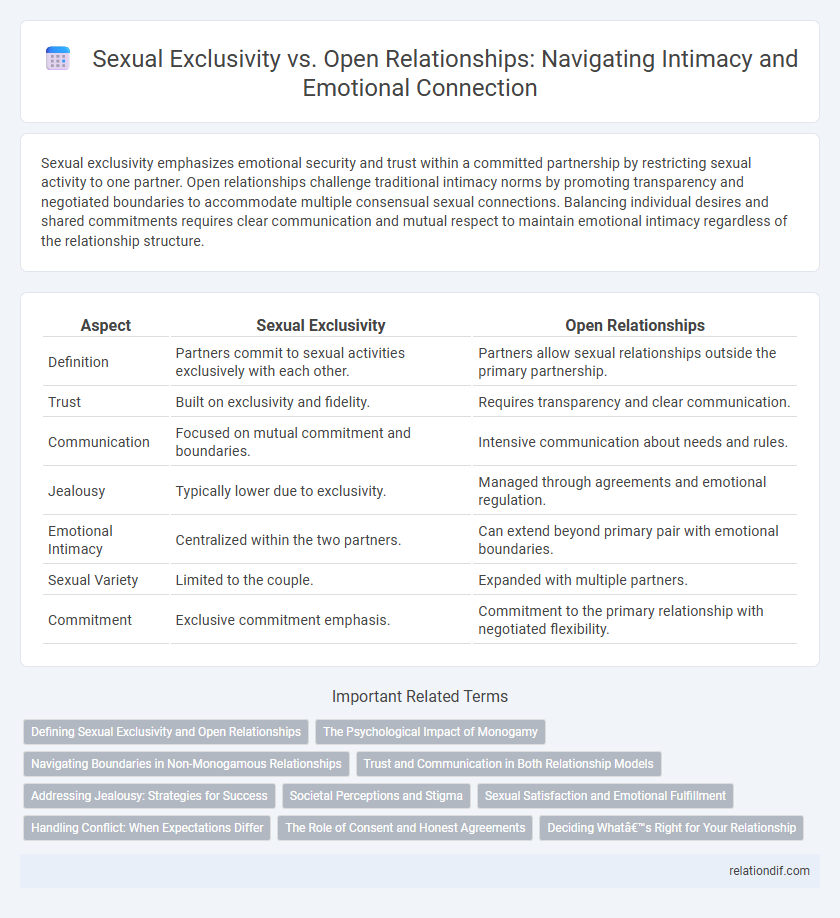Sexual exclusivity emphasizes emotional security and trust within a committed partnership by restricting sexual activity to one partner. Open relationships challenge traditional intimacy norms by promoting transparency and negotiated boundaries to accommodate multiple consensual sexual connections. Balancing individual desires and shared commitments requires clear communication and mutual respect to maintain emotional intimacy regardless of the relationship structure.
Table of Comparison
| Aspect | Sexual Exclusivity | Open Relationships |
|---|---|---|
| Definition | Partners commit to sexual activities exclusively with each other. | Partners allow sexual relationships outside the primary partnership. |
| Trust | Built on exclusivity and fidelity. | Requires transparency and clear communication. |
| Communication | Focused on mutual commitment and boundaries. | Intensive communication about needs and rules. |
| Jealousy | Typically lower due to exclusivity. | Managed through agreements and emotional regulation. |
| Emotional Intimacy | Centralized within the two partners. | Can extend beyond primary pair with emotional boundaries. |
| Sexual Variety | Limited to the couple. | Expanded with multiple partners. |
| Commitment | Exclusive commitment emphasis. | Commitment to the primary relationship with negotiated flexibility. |
Defining Sexual Exclusivity and Open Relationships
Sexual exclusivity refers to a relationship dynamic where partners agree to engage in sexual activity only with each other, fostering trust and emotional security. Open relationships allow partners the freedom to pursue sexual or romantic connections outside the primary partnership, emphasizing communication and consent. Understanding these definitions is crucial for navigating expectations and boundaries in intimate relationships.
The Psychological Impact of Monogamy
Monogamous relationships often foster a sense of security and emotional stability, which contributes to positive psychological well-being and lower levels of stress. The commitment to sexual exclusivity can enhance trust and deepen emotional intimacy, promoting long-term relationship satisfaction. However, the pressure to maintain monogamy may increase anxiety or feelings of constraint for some individuals, highlighting the importance of open communication and mutual consent.
Navigating Boundaries in Non-Monogamous Relationships
Navigating boundaries in non-monogamous relationships requires clear communication and mutual consent to establish sexual exclusivity parameters that honor all partners' needs. Defining limits and regularly revisiting agreements ensures trust and respect, preventing misunderstandings and emotional harm. Tools such as boundary mapping and scheduled check-ins help partners maintain transparency and adaptability in evolving dynamics.
Trust and Communication in Both Relationship Models
Sexual exclusivity relies heavily on trust built through consistent fidelity and clear communication about boundaries, fostering emotional security between partners. Open relationships demand even greater communication transparency, as partners negotiate rules and manage jealousy to maintain trust while allowing sexual freedom. Both models necessitate honest dialogue and mutual respect to sustain intimate connection and relational stability.
Addressing Jealousy: Strategies for Success
Addressing jealousy in sexual exclusivity versus open relationships involves clear communication, setting boundaries, and practicing emotional transparency to build trust. Couples succeed by regularly discussing feelings, acknowledging insecurities, and using coping strategies like reassurance and mutual respect. Emotional self-awareness and scheduled check-ins help manage jealousy and reinforce connection regardless of relationship structure.
Societal Perceptions and Stigma
Sexual exclusivity is often idealized in many cultures, with societal norms framing monogamous relationships as the standard for commitment and trust, while open relationships frequently face misunderstanding and moral judgment. Stigma surrounding non-monogamous arrangements stems from historical biases and misconceptions about loyalty and emotional depth, which can lead to social exclusion or negative stereotyping of individuals who pursue open relationships. Despite increasing visibility and acceptance, open relationships challenge traditional assumptions about intimacy, prompting ongoing debates about relationship ethics and personal freedom.
Sexual Satisfaction and Emotional Fulfillment
Sexual exclusivity in relationships often correlates with higher levels of sexual satisfaction due to established trust and clear boundaries. Open relationships can provide emotional fulfillment through increased communication and exploration, though they may require strong negotiation skills to maintain satisfaction. Both relationship styles demand intentional commitment to emotional needs and sexual well-being for optimal intimacy.
Handling Conflict: When Expectations Differ
Sexual exclusivity often establishes clear boundaries that simplify conflict resolution by aligning partners on fidelity expectations, reducing misunderstandings. In contrast, open relationships require ongoing communication and negotiation to handle differing desires and boundaries, which can introduce complexities but also foster deeper trust. Effective conflict management in either framework depends on mutual respect, transparency, and willingness to adapt to evolving emotional needs.
The Role of Consent and Honest Agreements
Sexual exclusivity and open relationships both rely heavily on clear consent and honest agreements to maintain trust and emotional safety. Explicit communication about boundaries, desires, and expectations ensures that all partners feel respected and secure, preventing misunderstandings and jealousy. Consent acts as the foundation for navigating intimacy dynamics, allowing relationships to honor individual needs while sustaining mutual respect.
Deciding What’s Right for Your Relationship
Sexual exclusivity involves commitment to one partner, fostering trust and emotional security, while open relationships embrace consensual non-monogamy to satisfy diverse needs and enhance personal freedom. Deciding what's right depends on clear communication, mutual boundaries, and aligning relationship goals with individual values. Evaluating emotional resilience and willingness to navigate jealousy plays a critical role in maintaining intimacy under either model.
Sexual Exclusivity vs Open Relationships Infographic

 relationdif.com
relationdif.com